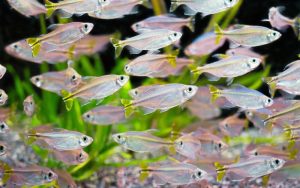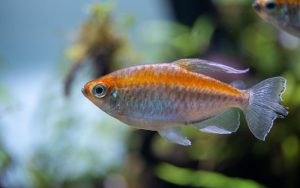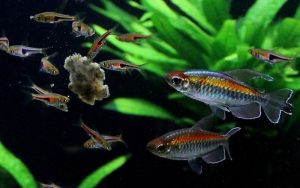Pimelodus pictus, also known as the pictus catfish, is a popular choice among aquarium fanatics for its beautiful appearance and active nature. However, mastering the care of these vibrant fish can be a challenging task for beginners.
With their stunning silver bodies and distinctive black spots, pictus cats can make a stunning addition to any aquarium, but they do require specific care and attention to thrive.
In this article, we will share three pro hacks for maintaining a vibrant tank with Pimelodus pictus. From water quality management to creating the perfect environment for these fish to thrive, we will cover all the crucial tips and tricks for keeping your pictus catfish happy and healthy.
Whether you’re a seasoned aquarium enthusiast looking to take your tank to the next level or a beginner looking to master the care of these stunning fish, these pro hacks will help you create a vibrant and thriving environment for your pimelodus pictus.
Table of Contents
TogglePimelodus Pictus Catfish Fish Species Profile
The Pimelodus Pictus catfish, also known as the pictus catfish or angel catfish, is a widespread species among freshwater aquarium enthusiasts. This catfish species is native to South America and is known for its striking appearance, with black spots and silver coloring.

Pictus catfish are relatively small, growing to an average length of around 5 inches. They are peaceful and social fish, making them suitable for community fish tanks.
However, they do require ample hiding places and prefer a well-maintained environment with proper water quality. Overall, the Pimelodus Pictus cat is a beautiful and fascinating addition to any freshwater aquarium. Though a rare find in the aquarium trade, the pictus catfish is occasionally mistaken for the sailfin pim.
Here is a profile of the Pimelodus pictus catfish.
- Family: Pimelodidae
- Order: Siluriformes
- Class: Actinopterygii
- Phylum: Chordata
- Kingdom: Animalia
Habitat:
The pimelodus pictus is native to the Amazon and Orinoco River basins in South America. They are found in slow-moving streams and rivers with sandy or muddy bottoms.
Description:
The pimelodus pictus is a small catfish that typically grows to about 4-5 inches in length. They have a slender body with a flattened head and a wide mouth. They are named for their beautiful coloration, which consists of a light brown body with dark brown spots and stripes. They also have long barbels that extend to their caudal fin.
Diet:
The pictus catfish is an omnivore and feeds on a variety of small invertebrates, such as worms, insects, and crustaceans.
Behavior:
The pictus cat is a peaceful fish that is relatively active during the day. They are bottom-dwellers and spend most of their time hiding under rocks or driftwood.
Reproduction:
The pictus catfish is an egg-layer. The females lay their eggs in a hidden location, and the males guard the eggs until they hatch.
Lifespan:
The pictus cats have a lifespan of about 4-8 years in captivity.
Care:
The pictus cats are relatively easy to fish to care for in an aquarium. They should be kept in an aquarium that is at least 20 gallons in size with plenty of hiding places.
The water temperature should be between 72 and 78°F, and the pH should be between 6.0 and 7.5. They are not picky eaters and will munch on a variety of foods, such as flakes, pellets, and frozen brine shrimp.
Overall, the pictus catfish is a beautiful and friendly fish that makes a great addition to any community aquarium.
Pimelodus pictus size
The size of the Pimelodus pictus can vary, but they generally grow to be around 4 – 6 inches (10 – 15 centimeters) in length.
However, in some cases, they may reach up to 8 inches (20 centimeters) in captivity. It’s important to note that the size of the fish can be influenced by factors such as diet, water quality, and the conditions of their environment.
When keeping Pimelodus pictus in an aquarium, it’s crucial to provide a suitable tank size and conditions to accommodate their growth. A tank of at least 30 gallons of water is recommended for a small group of pictus catfish. Additionally, maintaining good water quality and offering a well-balanced diet will contribute to their overall health and size.
Is the Pictus Catfish Right For Your Aquarium?
The pimelodus pictus fish is a popular choice for freshwater aquariums because of its attractive appearance, relatively small size, and peaceful nature.
Here are some things to consider before adding a pimelodus pictus to your aquarium:
- Size: Pictus catfish typically grow to be about 3-5 inches long, making them a good choice for smaller aquariums. However, they can grow up to six inches in ideal conditions, so be sure to choose an aquarium that is large enough to accommodate their adult size.
- Water conditions: Pictus catfish prefer warm water with a temperature range of 72-78 degrees Fahrenheit. They also prefer slightly acidic water with a pH range of 6.0-7.0.
- Tankmates: Pictus catfish are generally peaceful fish, but they can be nippy towards fins. They are best kept with other peaceful fish of similar size. Avoid keeping them with aggressive fish or fish that are too small, as they may be bullied or eaten.
- Diet: Pictus catfish are omnivores and will eat a variety of foods, including brine shrimp, flakes, pellets, and bloodworms. They are also good algae eaters, which can help to keep your aquarium clean.
- Hiding places: Pictus catfish are nocturnal and prefer to hide during the day. Be sure to provide them with plenty of hiding places, such as caves, driftwood, or plants.
Overall, the pictus catfish is a good choice for home aquariums of 20 gallons or more. They are relatively easy to care for and make a peaceful addition to the community tank.
If you are looking for a small, peaceful catfish that is easy to care for, the pimelodus pictus angelicus is a good option. However, if you have a smaller aquarium or you have aggressive fish in your tank, you may want to choose a different type of catfish.
Pictus Catfish Habitat and Care
The Pictus Catfish is a popular freshwater fish known for its striking appearance and active behavior. Native to the Orinoco and Amazon river basins in South America, these fish prefer a habitat with plenty of hideouts such as caves, driftwood, and plants.
They are also known to thrive in water with moderate to strong flow, so a good filtration system is essential for pictus catfish care.
Pictus Catfish are social creatures and should be kept in groups of at least 3-4 individuals to prevent stress and aggression. They are omnivorous and able to eat anything, including live, frozen, and sinking pellet foods. It’s essential to keep their diet well-rounded to ensure their health and vitality.
When it comes to tank setup, a minimum of a 30-gallon tank is recommended for a small group of pimelodus pictus angelicus. Ensure the tank has enough hiding spots and a strong filtration system to maintain water quality.
Overall, providing a well-maintained tank with plenty of hiding spots, good water flow, and a varied diet will help ensure the health and well-being of the Pictus Catfish.
Warning: Exercise caution when dealing with these fish to prevent accidental pricking from their sharp spines. Due to their tendency to become entangled in nets, it is advisable to utilize an open container for their handling.
3 Pro Hacks for Vibrant Pictus Cat Tanks
To keep pictus cat tanks vibrant and lively, three pro hacks can make a big difference. Certainly! Here are three pro hacks to keep your Pictus catfish tank vibrant and thriving:
- Optimal Lighting: Pictus catfish thrive in well-lit environments, mimicking their natural habitat. Use full-spectrum aquarium lighting to simulate daylight conditions. Ensure a consistent lighting schedule with around 10-12 hours of light per day. This helps promote the growth of live plants, enhances the natural colors of your Pictus catfish, and creates an overall vibrant tank.
- Aquascaping with Live Plants: Integrate live plants into your aquarium to create a more natural and visually appealing habitat. Choose plants that are compatible with the pictus cat pimelodus pictus and can withstand their activity. Plants not only provide hiding spots for the catfish but also contribute to the overall water quality by absorbing nitrates. Consider species like Anubias, Java Fern, or Amazon Swords for a lush and vibrant aquascape.
- Variety in Tank Decor: Enhance the aesthetic appeal of your tank by incorporating a variety of decorations. Pictus catfish are known for their playful and active nature, so they provide caves, driftwood, and other hiding spots. Use colorful gravel or substrate to add vibrancy to the bottom of the tank. Additionally, select decorations that won’t harm the sensitive barbels of the Pictus catfish. Creating a diverse and visually stimulating environment will encourage natural behaviors and keep your tank vibrant.
Remember to monitor water parameters regularly, perform routine water changes, and provide a balanced diet to ensure the overall health and vibrancy of your Pictus catfish tank.
Recommended Pimelodus Pictus tank mates
Pimelodus pictus is a popular and peaceful species that is often chosen for community aquariums. They can be kept with a variety of tank mates as long as they are not too aggressive or territorial. Here are some of the best tank mates for Pictus cory catfish:
- Giant Danios: These active and colorful fish are a good size for Pictus catfish and will not nip at their fins.
- Rainbow Sharks: These hardy and peaceful fish are a good choice for a community aquarium with Pictus catfish.
- Opaline Gourami: These beautiful and peaceful fish are a good match for Pictus catfish in terms of temperament and size.
- Bucktooth Tetra: These small and active fish are a good choice for a community aquarium with Pictus catfish.
- Rubber Pleco: These algae-eating catfish are a great addition to any aquarium with Pictus catfish. They will help to keep the tank clean and provide a good food source for the catfish.
- Blue Gularis Killifish: These peaceful and colorful fish are a good choice for a community aquarium with Pictus catfish.
- Tiger Barb: These active and colorful fish are a good size for Pictus catfish and will not nip at their dorsal fins.
- Zebra Danio: These small and active fish are a good choice for a community aquarium with Pictus catfish.
It is vital to choose tank mates that are similar in size and temperament to the Pictus catfish. Avoid keeping them with aggressive fish or fish that are much larger than them. It is also essential to provide the Pictus catfish with plenty of hiding places, such as rocks and driftwood.
With proper care, Pictus catfish can live for ten years or more. They are rewarding fish to keep and can make a remarkable addition to any home aquarium.
Pictus Catfish Diet and Feeding
The Pictus Cat is an omnivorous catfish species that requires a mixed diet to thrive in captivity. In the wild, they mainly feed on small crustaceans, worms, insects, and plant matter.
In an aquarium setting, they will readily accept a wide range of fish foods, including high-quality flake, pellet, and frozen foods such as bloodworms, brine shrimp, and daphnia.
It is vital to provide them with a balanced food that includes both protein and plant matter. While they are bottom dwellers, they are also active hunters and will appreciate frozen or live foods to simulate their natural foraging behavior.
Offering a mix of foods will help ensure that they receive all the necessary nutrients to support their health and well-being. It is also essential to avoid overfeeding, as they can quickly become overweight, which might lead to health issues. Therefore, it’s essential to monitor their feeding and adjust their diet accordingly.
Take care not to overfeed
It is essential to be mindful of how much you are feeding your Pimelodus pictus Angelicus, as overfeeding might lead to obesity and health issues. Stick to a balanced and moderate feeding schedule, keeping in mind the size of the fish and its individual needs. This will ensure a happy and healthy fish.
Frozen Foods (Bloodworms and Blackworms)
Frozen bloodworms and blackworms are excellent options for feeding Pimelodus pictus angelicas. These frozen foods are convenient and easy to store, providing essential nutrients and protein for the fish. They can also be used as a supplement to the fish’s diet, ensuring they receive a well-rounded feeding routine.
Pictus catfish tank requirements
Pictus catfish are an admired choice for aquariums due to their delicate nature and striking appearance. However, they do require a particular tank setup to thrive. Here are the minimum tank requirements for pictus catfish:
- Tank size: A minimum of a 55-gallon tank is required for a single pictus catfish. For every additional pictus catfish, you will need an extra 10 gallons of space.
- Water parameters: Pictus catfish prefer water temperatures between 75-80 degrees Fahrenheit, with a pH of 6.0-7.5.
- Filtration: A robust filtration system is essential to keep the water clean and healthy for your pictus catfish. A canister filter with a flow rate of at least 300 gallons per hour is recommended.
- Substrate: Pictus catfish prefer a soft, sandy substrate that is easy to clean. Avoid gravel or other substrates that could scratch their delicate barbels.
- Decorations: Pictus catfish like to have plenty of places to hide and explore. Driftwood, rocks, and live plants are all excellent options.
- Diet: Pictus catfish are omnivores and will eat anything that fits in their mouth, including flake food, pellets, live worms, and frozen shrimp.
Here are some additional tips for keeping pictus catfish:
- Keep pictus catfish in groups of at least 3-5 individuals. They are social fish and do better in groups.
- Pictus catfish are relatively peaceful fish, but they can be aggressive towards smaller fish. Avoid keeping them with Neon tetras, danios, or other small fish.
- Pictus catfish are nocturnal fish, so that they will be most active at night. Provide them with plenty of hiding places during the day.
With proper care, pictus catfish can live for 10 years or more. They are a rewarding fish to keep and will make a pretty addition to your aquarium.
Commonly Asked Questions about Pimelodus pictus catfish (FAQs)
Will Pictus catfish eat bugs?
Yes, Pictus catfish are omnivorous and will eat a variety of bugs, including dragonfly larvae, worms, and insects. They are also scavengers and will eat algae and other detritus.
Do Pictus catfish make noise?
Yes, Pictus catfish can make noise. They produce low-frequency drumming sounds using their swimbladders and high-frequency stridulation sounds by rubbing their dorsal and pectoral fin spines together. These sounds are used for communication, such as defending their territory or attracting mates.
What are Pictus catfish good for?
Pictus catfish are popular aquarium fish because of their striking appearance, peaceful nature, and engaging behavior. They are also relatively easy to care for.
Do Pictus catfish eat worms?
Yes, pictus catfish eat worms. Worms are a great source of protein for pictus catfish, and they will eat a variety of worms, including bloodworms, earthworms, and tubifex worms.
What do Pictus catfish do?
Pictus catfish are active swimmers and scavengers that primarily feed at night. They use their long barbels to sense their surroundings and locate food in murky waters. Pictus catfish are also known to make drumming and stridulation sounds for communication purposes.
Will a Pictus catfish eat other fish?
Yes, Pictus catfish are opportunistic omnivores and will eat other tankmates if they are small enough to fit in their mouths. They are not aggressive fish, but they will eat smaller fish if they are hungry. If you are keeping Pictus catfish with other fish, make sure that the other fish are at least 2 inches long.
Can I have 2 Pictus catfish?
Yes, you can have two Pictus catfish in a tank that is at least 55 gallons. Pictus catfish are social fish and do best in groups of three or more. However, it is vital to make sure that the tank is large enough to accommodate the fish, as they can grow to be up to 12 inches long.
What size tank does a 4-line Pictus catfish need?
A four-line pictus catfish needs a tank size of at least 55 gallons. This will provide them with enough swimming space and will also help keep the water quality high. If you are planning on keeping more than one pictus catfish, you will need a larger tank.
What should I feed my Pictus catfish?
Pictus catfish are omnivores and require a varied diet of high-quality fish food, including wafers, sinking pellets, and live or frozen foods like blackworms, bloodworms, and brine shrimp. Occasional treats of chopped vegetables, such as zucchini or cucumber, can also be offered.
Are pictus catfish bottom feeders?
Yes, pictus catfish are bottom feeders. They spend most of their time scavenging for food at the bottom of the tank. They have long barbels that they use to sense their surroundings and locate food in murky waters.
Conclusion
In conclusion, the mesmerizing world of aquarium fish has captured the hearts of enthusiasts worldwide. From vibrant tropical species to the elusive and captivating Pimelodus pictus cats, these aquatic wonders bring life and color to our homes. As we bid farewell to this definitive blog post, let us remember the importance of preserving these delicate ecosystems and respecting the natural habitats of our finned friends. So, whether you’re a seasoned aquarist or a curious beginner, dive into the enchanting realm of Pimelodus pictus and discover the beauty that lies beneath the surface.
You might also like
- 7 Best Types of Catfish for Aquarium: Boost Your Tank Beauty
- Can You Put Catfish with Goldfish: 7 Vital Tips for Success
- Do Catfish Eat Goldfish? (Top 9 Most Safe Goldfish Mates)
- Green Cory Catfish: Ultimate Care Guide, Tank Mates & More!
- Brown Algae in Fish Tank: 5 Surefire Hacks to Remove Forever
- Are Pictus Catfish Aggressive: 5 Sneaky Signs & Quick Fixes!
- Four Line Pictus Catfish 101: a Comprehensive Care Guide!
- Can Pictus Catfish Live with Goldfish: (The Shocking Truth)
- Good Tank Mates for Pictus Catfish for Thriving Aquarium
- Pictus Cat fish Size: 5 Astonishing Facts You Won’t Believe!
- 5 Powerful Pictus Catfish Favorite Food Secrets for Ultimate Thriving




